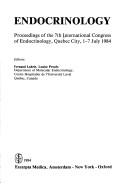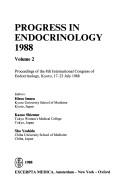| Listing 1 - 10 of 43 | << page >> |
Sort by
|
Article
Year: 1955
Abstract | Keywords | Export | Availability | Bookmark
 Loading...
Loading...Choose an application
- Reference Manager
- EndNote
- RefWorks (Direct export to RefWorks)
Adrenalin. --- Autonomic nervous system. --- Blood pressure. --- Fear. --- Mecholyl. --- Physiology.
Article
Abstract | Keywords | Export | Availability | Bookmark
 Loading...
Loading...Choose an application
- Reference Manager
- EndNote
- RefWorks (Direct export to RefWorks)
Acth. --- Activity. --- Adrenalin. --- Insulin. --- Ldh. --- Mice. --- Selection. --- Stress.
Book
ISBN: 9781633210875 1633210871 1633210847 9781633210844 Year: 2014 Publisher: New York
Abstract | Keywords | Export | Availability | Bookmark
 Loading...
Loading...Choose an application
- Reference Manager
- EndNote
- RefWorks (Direct export to RefWorks)
Adrenaline. --- Adrenalin --- Epinephrine --- Bronchodilator agents --- Catecholamines --- Neurotransmitters --- Sympathomimetic agents --- Adrenergic mechanisms
Multi
ISBN: 9090012818 Year: 1986 Publisher: Nijmegen s.n.
Abstract | Keywords | Export | Availability | Bookmark
 Loading...
Loading...Choose an application
- Reference Manager
- EndNote
- RefWorks (Direct export to RefWorks)
591.147 --- 591.44 --- Internal secretions. Endocrine secretions. Hormones. Adrenalin. Insulin. Sex hormones. Androgens. Oestrogens --- Lymphatic system of vertebrates --- Theses --- 591.44 Lymphatic system of vertebrates --- 591.147 Internal secretions. Endocrine secretions. Hormones. Adrenalin. Insulin. Sex hormones. Androgens. Oestrogens

ISBN: 0444806377 Year: 1984 Volume: vol 655 Publisher: Amsterdam Excerpta medica
Abstract | Keywords | Export | Availability | Bookmark
 Loading...
Loading...Choose an application
- Reference Manager
- EndNote
- RefWorks (Direct export to RefWorks)
Pathological endocrinology --- 591.147 --- 577.175.2/.7 --- Endocrinology --- -Internal medicine --- Hormones --- Internal secretions. Endocrine secretions. Hormones. Adrenalin. Insulin. Sex hormones. Androgens. Oestrogens --- Animal hormones --- Congresses --- -Internal secretions. Endocrine secretions. Hormones. Adrenalin. Insulin. Sex hormones. Androgens. Oestrogens --- 577.175.2/.7 Animal hormones --- 591.147 Internal secretions. Endocrine secretions. Hormones. Adrenalin. Insulin. Sex hormones. Androgens. Oestrogens --- Congresses. --- -577.175.2/.7 Animal hormones --- Klieren (Endocrine). Ziekten. (Congres) --- Glandes endocrines. Maladies. (Congrès) --- Endocrinologie. (Congrès) --- Endocrinologie. (Congres)
Book
ISBN: 0674074734 0674074718 9780674074712 9780674050884 0674050886 Year: 2013 Publisher: Cambridge, MA
Abstract | Keywords | Export | Availability | Bookmark
 Loading...
Loading...Choose an application
- Reference Manager
- EndNote
- RefWorks (Direct export to RefWorks)
Inducing highs of excitement, anger, and terror, adrenaline fuels the extremes of human experience. A rush empowers superhuman feats in emergencies. Risk-taking junkies seek to replicate this feeling in dangerous recreations. And a surge may literally scare us to death. Adrenaline brings us up to speed on the fascinating molecule that drives some of our most potent experiences. Adrenaline was discovered in 1894 and quickly made its way out of the lab into clinics around the world. In this engrossing account, Brian Hoffman examines adrenaline in all its capacities, from a vital regulator of physiological functions to the subject of Nobel Prize-winning breakthroughs. Because its biochemical pathways are prototypical, adrenaline has had widespread application in hormone research leading to the development of powerful new drugs. Hoffman introduces the scientists to whom we owe our understanding, tracing the paths of their discoveries and aspirations and allowing us to appreciate the crucial role adrenaline has played in pushing modern medicine forward. Hoffman also investigates the vivid, at times lurid, place adrenaline occupies in the popular imagination, where accounts of its life-giving and lethal properties often leave the realm of fact. Famous as the catalyst of the "fight or flight" response, adrenaline has also received forensic attention as a perfect poison, untraceable in the bloodstream-and rumors persist of its power to revive the dead. True to the spirit of its topic, Adrenaline is a stimulating journey that reveals the truth behind adrenaline's scientific importance and enduring popular appeal.
Adrenaline --- History, Modern --- Adrenalin --- Epinephrine --- Bronchodilator agents --- Catecholamines --- Neurotransmitters --- Sympathomimetic agents --- Adrenergic mechanisms --- World history --- History. --- History --- Annals --- Auxiliary sciences of history
Book
ISBN: 1634840216 9781634840217 9781634836005 Year: 2016 Publisher: New York
Abstract | Keywords | Export | Availability | Bookmark
 Loading...
Loading...Choose an application
- Reference Manager
- EndNote
- RefWorks (Direct export to RefWorks)
Monoamine oxidase --- Adrenalin oxidase --- Benzylamine oxidase --- MAO (Enzyme) --- Monamine oxidase --- Tyraminase --- Tyramine oxidase --- Amine oxidase --- Metalloenzymes --- Inhibitors --- Therapeutic use. --- Therapeutic use --- Side effects.

ISBN: 0444810412 Year: 1988 Volume: vol 799 Publisher: Amsterdam Excerpta medica
Abstract | Keywords | Export | Availability | Bookmark
 Loading...
Loading...Choose an application
- Reference Manager
- EndNote
- RefWorks (Direct export to RefWorks)
Endocrinology --- Endocrinology. --- 591.147 --- 612.43 --- Endocrinology and Metabolism Specialty --- Metabolism and Endocrinology Specialty --- Endocrine System Diseases --- Congresses. --- Internal secretions. Endocrine secretions. Hormones. Adrenalin. Insulin. Sex hormones. Androgens. Oestrogens --- Endocrine physiology. Internal secretions. Ductless glands. Hormones. Endocrinology --- congresses. --- 612.43 Endocrine physiology. Internal secretions. Ductless glands. Hormones. Endocrinology --- 591.147 Internal secretions. Endocrine secretions. Hormones. Adrenalin. Insulin. Sex hormones. Androgens. Oestrogens --- Congresses
Dissertation

ISBN: 9789086491582 Year: 2008 Publisher: Leuven K.U.Leuven. Faculteit Wetenschappen
Abstract | Keywords | Export | Availability | Bookmark
 Loading...
Loading...Choose an application
- Reference Manager
- EndNote
- RefWorks (Direct export to RefWorks)
Ecdysteroiden spelen een sleutelrol bij zowel larvale als volwassen zwermsprinkhanen. Gedurende het larvale leven, fungeren deze moleculen als vervellingshormonen en worden ze, tenminste volgens de klassieke opvattingen, gesecreteerd door de prothoracale klieren (PK). Bij volwassen dieren daarentegen, waar ze worden vrijgezet door de gonaden, spelen ze een rol bij verschillende reproductie-gerelateerde processen, gaande van de differentiatie van spermatocyten tot vitellogenese. Een studie van de ultrastructuur van de PK van de woestijnsprinkhaan S. gregaria genereerde ondersteunende argumenten voor de hypothese dat ze naast ecdysteroiden ook proteïne-achtige substanties vrijzetten. De verschillen die zowel op het lichtmicroscopisch- als het ultrastructurele niveau tussen de klieren van solitaire en gregaire dieren werden waargenomen, zouden een weerspiegeling kunnen zijn van mogelijke verschillen in aard en/of hoeveelheid van deze gesecreteerde moleculen. Recent werd het bestaan van een autocriene factor (AF) gesecreteerd door de PK van B. mori aangetoond. Een gelijkaardige factor blijkt ook voor te komen in de PK van zwermsprinkhanen. Er kan dus worden verondersteld dat het voorkomen van een dergelijke factor wijdverspreid is in de insectenwereld. Veranderingen in de gevoeligheid voor het prothoracicotroop hormoon (PTTH) en deze AF werden doorheen het laatste larvale stadium van de Afrikaanse treksprinkhaan L. migratoria nagegaan. Daaruit blijkt AF vooral belangrijk te zijn voor het onderhouden van een zekere basale ecdysteroidconcentratie, terwijl het PTTH verantwoordelijk is voor de grote ecdysteroid piek noodzakelijk voor de vervelling. De combinatie van beide factoren had een cumulatief effect, wat er op zou kunnen wijzen dat ze via verschillende signaalwegen werken. De gonaden zijn de voornaamste ecdysteroidogene weefsels tijdens het volwassen stadium. We konden aantonen dat testes en ovaria van zwermsprinkhanen uit het laatste larvale stadium, die op dat moment reeds goed ontwikkeld zijn, ook ecdysteroiden secreteren. De grote ecdysteroid piek op het einde van dit stadium zou dan het gevolg zijn van de secretie van zowel gonaden als PK. Bovendien lijkt het erop dat de ecdysteroidsecretie door deze organen gereguleerd wordt door een laag moleculair-gewicht ecdysiotropine. Twee pogingen werden ondernomen om deze factor op te zuiveren en er zijn sterke aanwijzingen dat het een deel is van de adipokinetisch hormoon precursor. Tot slot kunnen we besluiten dat de zienswijze, waarbij een ‘groot PTTH’ als enige de ecdysteroidogenese reguleert, voorbijgestreefd is. Een toenemend aantal betrokken factoren wijst erop dat de situatie in de realiteit complexer is. Ecdysteroids are key players in both larval and adult locusts. During larval life, they act as moulting hormones, and they are secreted by the prothoracic glands (PGs), at least according to the classical view. In adults on the other hand, where they are secreted by the gonads, they play a role in a variety of reproductive processes ranging from spermatocyte differentiation to vitellogenesis. An ultrastructural study of the PGs of the desert locust S. gregaria gave credit to the old hypothesis that they might secrete proteinaceous substances in addition to ecdysteroids. The differences between PGs of gregarious and solitarious locusts, both at the light-microscopic as at the ultrastructural level, might reflect differences in the nature and/or amount of these secreted molecules. The existence of a factor secreted by the PGs of B. mori that stimulates their own ecdysteroidogenesis was reported recently. We have demonstrated that a similar ‘autocrine factor’ (AF) is present in the PGs of locusts. Therefore, we assume that autocrine stimulation of ecdysteroidogenesis is a widespread phenomenon in insects. Changes in responsiveness to prothoracicotropic hormone (PTTH) and AF were monitored throughout the last larval stadium. Apparently, AF seems to play a critical role in maintaining basal ecdysteroid secretion during the early stages of the last larval stadium, whereas PTTH elicits the major ecdysteroid peak necessary for moulting. Combination of both factors yielded a cumulative effect, suggesting that different action mechanisms and different receptors may be involved in the action of AF and PTTH. During adult life, the gonads are the main ecdysteroidogenic tissues. We demonstrated that testes and ovaries from last larval stadium migratory locusts, which are already developed quite well at that stage, also release ecdysteroids. The large ecdysteroid peak in the haemolymph at the end of the last larval stadium appears to be the result of the cumulated release by both PGs and gonads. The release of ecdysteroids by the PGs and the gonads was shown to be under the control of a single small ecdysiotropin. Two purification attempts were undertaken, and strong evidence was found that this peptide is contained within the adipokinetic hormone precursor. In conclusion, we have demonstrated that an increasing number of factors control ecdysteroidogenesis in locusts. The classical view, with the large PTTHs as the sole players controlling the PGs, has become too narrow to fully explain all involved processes.
Academic collection --- 591.147 --- 595.728 --- Internal secretions. Endocrine secretions. Hormones. Adrenalin. Insulin. Sex hormones. Androgens. Oestrogens --- Locustidae. Long-horned grasshoppers. Locusts --- Theses --- 595.728 Locustidae. Long-horned grasshoppers. Locusts --- 591.147 Internal secretions. Endocrine secretions. Hormones. Adrenalin. Insulin. Sex hormones. Androgens. Oestrogens
Book
ISBN: 2130355404 9782130355403 Year: 1978 Publisher: Paris: PUF,
Abstract | Keywords | Export | Availability | Bookmark
 Loading...
Loading...Choose an application
- Reference Manager
- EndNote
- RefWorks (Direct export to RefWorks)
Vertebrates --- Endocrinology --- Vertébrés --- Endocrinologie --- Physiology --- Physiologie --- 596 --- 591.147 --- Vertebrata. Vertebrates in general --- Internal secretions. Endocrine secretions. Hormones. Adrenalin. Insulin. Sex hormones. Androgens. Oestrogens --- Vertebrates. --- 591.147 Internal secretions. Endocrine secretions. Hormones. Adrenalin. Insulin. Sex hormones. Androgens. Oestrogens --- 596 Vertebrata. Vertebrates in general --- Vertébrés
| Listing 1 - 10 of 43 | << page >> |
Sort by
|

 Search
Search Feedback
Feedback About UniCat
About UniCat  Help
Help News
News